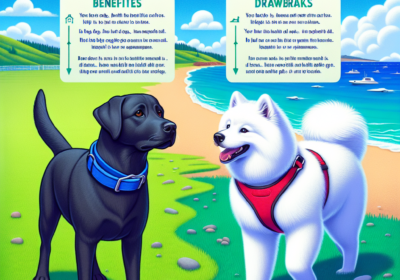Creating a Stress-Free Training Environment for Your Dog
Table of Contents
Creating a stress-free training environment for your dog is essential for fostering a positive learning experience and strengthening the bond between you and your canine companion. A calm and supportive atmosphere not only enhances your dog’s ability to learn new commands and behaviors but also reduces anxiety and behavioral issues. By understanding your dog’s needs, utilizing positive reinforcement techniques, and setting clear, consistent boundaries, you can create a nurturing space where your dog feels safe and motivated to learn. This approach not only promotes effective training but also contributes to the overall well-being and happiness of your pet.
Establishing Consistent Routines for Your Dog’s Training
Creating a stress-free training environment for your dog is essential for fostering a positive learning experience and ensuring effective communication between you and your canine companion. Establishing consistent routines is a fundamental aspect of this process, as it provides structure and predictability, which are crucial for reducing anxiety and enhancing focus during training sessions. By implementing a consistent routine, you can create a stable environment that encourages your dog to engage actively and willingly in the learning process.
To begin with, it is important to set a regular schedule for training sessions. Dogs thrive on routine, and having a set time each day for training helps them anticipate and prepare for the activity. This predictability reduces stress and allows your dog to approach training with a calm and focused mindset. Consistency in timing also aids in reinforcing the behaviors you wish to instill, as it creates a pattern that your dog can easily recognize and follow.
In addition to scheduling, maintaining consistency in the location of training sessions can significantly contribute to a stress-free environment. Choosing a quiet, familiar space minimizes distractions and helps your dog concentrate on the tasks at hand. A consistent training location also signals to your dog that it is time to focus and learn, further reinforcing the routine. Over time, this familiarity with the environment can enhance your dog’s confidence and willingness to participate in training activities.
Moreover, using consistent commands and cues is vital in establishing a clear line of communication with your dog. Dogs learn through repetition and association, so using the same words and gestures for specific commands helps them understand what is expected. Inconsistencies in language can lead to confusion and frustration, hindering the training process. Therefore, it is essential to ensure that all family members or individuals involved in the training use the same commands to maintain clarity and avoid mixed signals.
Furthermore, incorporating positive reinforcement consistently throughout the training process is crucial for creating a stress-free environment. Rewarding your dog with treats, praise, or playtime when they successfully perform a task reinforces the desired behavior and motivates them to continue learning. Consistent positive reinforcement not only builds your dog’s confidence but also strengthens the bond between you and your pet, making training a more enjoyable experience for both parties.
Transitioning from one training activity to another should also be done with consistency and care. Gradually introducing new commands or skills while maintaining a familiar routine helps prevent overwhelming your dog. By breaking down complex tasks into smaller, manageable steps, you can ensure that your dog remains engaged and stress-free throughout the training process. This methodical approach allows your dog to build on their existing knowledge and skills, fostering a sense of achievement and progress.
In conclusion, establishing consistent routines is a cornerstone of creating a stress-free training environment for your dog. By adhering to regular schedules, maintaining consistent locations, using clear commands, and employing positive reinforcement, you can create a structured and supportive atmosphere that encourages your dog to learn and thrive. This approach not only enhances the effectiveness of the training but also strengthens the bond between you and your canine companion, paving the way for a harmonious and fulfilling relationship.
Using Positive Reinforcement Techniques to Reduce Stress

Creating a stress-free training environment for your dog is essential for fostering a positive relationship and ensuring effective learning. One of the most effective methods to achieve this is through the use of positive reinforcement techniques. These techniques not only promote a harmonious atmosphere but also encourage desirable behaviors in a gentle and supportive manner. By understanding and implementing these strategies, dog owners can significantly reduce stress for their pets during training sessions.
To begin with, it is important to recognize that dogs, much like humans, respond better to encouragement and rewards than to punishment. Positive reinforcement involves rewarding a dog for exhibiting desired behaviors, thereby increasing the likelihood of those behaviors being repeated. This approach is grounded in the principles of operant conditioning, where the focus is on reinforcing good behavior rather than punishing undesirable actions. By using treats, praise, or play as rewards, owners can create a positive association with training activities, making the process enjoyable for the dog.
Moreover, timing is crucial when employing positive reinforcement techniques. The reward must be given immediately after the desired behavior is exhibited to ensure that the dog makes a clear connection between the action and the reward. This immediacy helps in reinforcing the behavior effectively, reducing any potential confusion for the dog. Consistency in this practice is equally important, as it helps the dog understand what is expected and builds a reliable pattern of behavior.
In addition to timing and consistency, the choice of reward plays a significant role in reducing stress during training. It is essential to select rewards that are highly motivating for the dog. While treats are commonly used, it is important to consider the individual preferences of the dog. Some dogs may respond better to verbal praise or physical affection, while others may find playtime with a favorite toy more rewarding. By tailoring the reward to the dog’s preferences, owners can enhance the effectiveness of the training session and maintain the dog’s interest and enthusiasm.
Furthermore, creating a calm and controlled environment is vital for minimizing stress during training. Distractions should be minimized to help the dog focus on the task at hand. This can be achieved by choosing a quiet location and gradually introducing distractions as the dog becomes more proficient in the desired behavior. Additionally, keeping training sessions short and engaging can prevent the dog from becoming overwhelmed or bored, which can lead to stress.
It is also beneficial to observe the dog’s body language and emotional state throughout the training process. Signs of stress, such as yawning, lip licking, or avoiding eye contact, should be addressed promptly. If a dog appears stressed, it may be necessary to take a break or adjust the training approach to ensure the dog remains comfortable and receptive.
In conclusion, using positive reinforcement techniques is an effective way to create a stress-free training environment for your dog. By focusing on rewarding desired behaviors, ensuring timely and consistent reinforcement, selecting appropriate rewards, and maintaining a calm training setting, dog owners can significantly reduce stress and enhance the learning experience for their pets. This approach not only strengthens the bond between owner and dog but also promotes a lifetime of positive behavior and mutual understanding.
Creating a Calm and Safe Space for Effective Dog Training
Creating a stress-free training environment for your dog is essential for effective learning and fostering a strong bond between you and your canine companion. A calm and safe space not only enhances the training experience but also ensures that your dog feels secure and confident. To achieve this, it is important to consider several factors that contribute to a conducive training atmosphere.
First and foremost, selecting an appropriate location is crucial. Ideally, the training area should be free from distractions such as loud noises, other animals, or excessive foot traffic. A quiet room in your home or a secluded spot in your backyard can serve as an excellent starting point. By minimizing external stimuli, you allow your dog to focus solely on the training tasks at hand, thereby increasing the likelihood of successful learning.
In addition to choosing the right location, it is vital to establish a consistent routine. Dogs thrive on predictability, and a structured schedule helps them understand what is expected of them. Consistency in training times and methods reinforces learning and reduces anxiety. Moreover, maintaining a regular routine allows your dog to anticipate training sessions, which can lead to increased enthusiasm and engagement.
Furthermore, the use of positive reinforcement is a key component in creating a stress-free training environment. Reward-based training methods, such as treats, praise, or play, encourage desired behaviors and strengthen the bond between you and your dog. By focusing on positive reinforcement, you create an atmosphere of encouragement and support, which is essential for building your dog’s confidence and willingness to learn.
Equally important is the need to be patient and understanding. Dogs, like humans, have varying learning paces and may require different amounts of time to grasp new concepts. It is crucial to remain patient and avoid expressing frustration, as negative emotions can create a stressful environment and hinder progress. Instead, celebrate small victories and acknowledge your dog’s efforts, which will motivate them to continue learning.
Moreover, it is beneficial to incorporate short, focused training sessions. Dogs have limited attention spans, and lengthy sessions can lead to fatigue and decreased effectiveness. By keeping training sessions brief and engaging, you ensure that your dog remains attentive and eager to participate. Additionally, ending each session on a positive note reinforces the idea that training is a rewarding and enjoyable experience.
Another important aspect to consider is the physical comfort of your dog during training. Ensure that the training area is free from hazards and that your dog has access to water and a comfortable resting place. A physically comfortable dog is more likely to be mentally relaxed and receptive to learning.
Lastly, it is essential to be mindful of your own demeanor during training sessions. Dogs are highly perceptive and can pick up on their owner’s emotions. By maintaining a calm and composed attitude, you set the tone for a stress-free environment. Your dog will mirror your calmness, making the training process smoother and more effective.
In conclusion, creating a stress-free training environment for your dog involves careful consideration of location, routine, reinforcement methods, and your own behavior. By prioritizing these elements, you foster a safe and supportive atmosphere that enhances learning and strengthens the bond between you and your dog. Through patience, consistency, and positive reinforcement, you can ensure that your dog not only learns effectively but also enjoys the training process.









![The Dog Podcast Uncovers Startling Truths About What We Feed Our Dogs [Press Release]](https://yourhomeandgardenhub.com.au/wp-content/uploads/2024/08/dog-bowl-400x280.webp)
